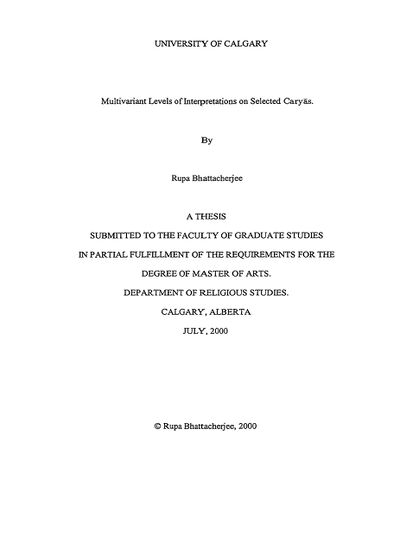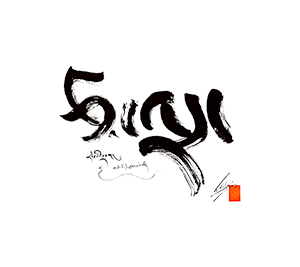- Approvalii
- Abstractiii
- Acknowledgementsiv
- Dedicationv
- Abbreviationsvi
- I. Introduction4
- II. Comparative Doctrines10
- III. History of Buddhism in Bengal38
- 1. Socio-economic Background38
- 2. The Rise and fall of Buddhist Dynasties in Bengal41
- IV. Definitions of Buddha Nature47
- 1. The Tathāgatagarbha Theory47
- a. Definition of tathāgatagarbha51
- b. Tathāgatagarbha as already Buddha55
- c. Conventional and Higher Truths56
- 2. The Sahaja Theory57
- 3. Mahāsukha58
- 4. Mahāmudrā59
- 5. The meanings of terms summarized61
- 1. The Tathāgatagarbha Theory47
- IV. SANDHABHĀṢĀ (twilight language)62
- VI. Transliterated Verses of the Caryāgitīs69
- 1. CARYĀ THREE: A Grog Shop69
- a. Part One: About the Author: Birūpa69
- b. Part Two: Textual Studies and Translations71
- c. Translations:73
- d. Sandhabhāṣā :75
- e. Mahāmudra depictions in sandhabhāṣā81
- 2. CARYĀ NINE: A Mad Elephant83
- a. Part one: About the author: Kānhā83
- b. Part Two: Textual Studies and translation84
- c. Translations:86
- d. Sandhabhāṣā:87
- e. Mahāmudra depictions in sandhabhāṣā93
- 3. CARYĀ THIRTY-SIX: A Carefree Stalwart96
- a. Part one: About the author: Kṛṣṇācarya96
- b. Part Two: Textual Studies and translation96
- c. Translations:97
- d. Sandhabhāṣā :98
- e. Mahāmudra depictions in sandhabhāṣā100
- 4. CARYĀ FORTY: Futility of Religiosity102
- a. Part one: About the author: Kāṇhu102
- b. Part Two: Textual Studies and translation102
- c. Translations:103
- d. Sandhabhāṣā :103
- e. Mahāmudra depictions in sandhabhāṣā105
- 5. CARYĀ FORTY-TWO: Life and Death107
- a. Part one: About the author: Kāha107
- b. Part Two: Textual Studies and translation107
- c. Translations:107
- d. Sandhabhāṣā:108
- e. Mahāmudra depictions in sandhabhāṣa109
- 6. CARYĀ FIFTEEN: A Benighted Traveler111
- a. Part one: About the author: Śānti111
- b. Part Two: Textual Studies and translation111
- c. Translations:113
- d. Sandhabhāṣā:116
- e. Mahāmudra depictions in sandhabhāṣā118
- 7. CARYĀ TWENTY-EIGHT: A Couple of Savara Lovers120
- a. Part one: About the author: Śavaripa120
- b. Part Two: Textual Studies and translation121
- c. Translations:122
- d. Sandhabhāṣā :124
- e. Mahāmudra depictions in sandhabhāṣā129
- 8. CARYĀ TWENTY-NINE: The Unreal Reality131
- a. Part one: About the author: Lūipā131
- b. Part Two: Textual Studies and translation131
- c. Translations:132
- d. Sandhabhāṣā:133
- e. Mahāmudra depictions in sandhabhāṣā134
- 9. CARYĀ THIRTY: The Rising Moon136
- a. Part one: About the author: Bhusuku136
- b. Part Two: Textual Studies and translation136
- c. Translations:137
- d. Sandhabhāṣā:137
- e. Mahāmudra depictions in sandhabhāṣā139
- 10. CARYĀ THRITY-SEVEN: An Experience of the Innate140
- a. Part one: About the author: Tāṛakapā140
- b. Part Two: Textual Studies and translation140
- c. Translations141
- d. Sandhabhāṣā142
- e. Mahāmudra depictions in sandhabhāṣā144
- 11. CARYĀ THIRTY-EIGHT: Paddling and towing a boat146
- a. Part one: About the author: Saraha146
- b. Part Two: Textual Studies and translation147
- c. Translations:148
- d. Sandhabhāṣā:149
- e. Mahāmudra depictions in sandhabhāṣā150
- 12. CARYĀ THIRTY-NINE: A Hapless Householder152
- a. About The Author: Saraha152
- b. Part Two: Textual Studies and translation152
- c. Translation:154
- d. Sandhabhāṣā:155
- e. Mahāmudra depictions in sandhabhāṣā157
- 1. CARYĀ THREE: A Grog Shop69
- VII. Conclusion159
- VIII. Bibliography165

